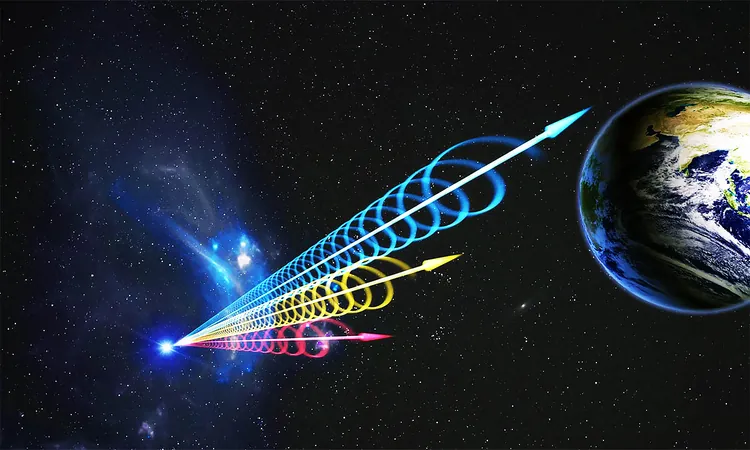
8 Billion-Year-Old Radio Signal Hits Earth, Unraveling Universal Mysteries!
2024-09-21
Groundbreaking Detection of an Ancient Cosmic Signal
In a groundbreaking achievement, astronomers have detected an astounding burst of radio waves that traveled 8 billion years to reach our planet. This celestial phenomenon, designated as FRB 20220610A, stands out as one of the most distant and energetic fast radio bursts (FRBs) ever recorded.
Understanding Fast Radio Bursts
Fast Radio Bursts are brief, intense flashes of radio waves that usually last just milliseconds, yet their origins remain shrouded in mystery. Scientists have proposed various theories about their source — from neutron stars to exotic astrophysical events — but the exact cause remains elusive.
Implications for Cosmic Understanding
As humanity gazes into the cosmos, the implications of these signals challenge and expand our understanding of the universe. The very nature of FRBs suggests they may originate from regions of space far beyond our Milky Way galaxy, offering tantalizing clues about processes and events that are still largely unknown to us.
Expert Insights and Technological Advances
Dr. Stuart Ryder, an esteemed astronomer at Macquarie University, is part of a dedicated team working tirelessly to uncover the secrets behind this cosmic signal. “We used ASKAP’s radio dishes to skillfully pinpoint where the burst came from,” Dr. Ryder revealed, showcasing the advanced technologies being utilized in this quest.
FRBs and Their Connection to Magnetars
What’s particularly fascinating about FRBs is their potential link to magnetars — dense remnants of exploded stars that emit intense energy. For instance, the recent FRB emitted energy comparable to what our sun generates over 30 years, but in a fraction of that time.
Tracing the Burst's Origins
As researchers continue their exploration, their use of the Australian Square Kilometre Array Pathfinder (ASKAP) and other advanced telescopes, like the European Southern Observatory’s Very Large Telescope, has allowed them to trace the burst back to an ancient, distant galaxy. This discovery marks it as the oldest FRB source found thus far.
FRBs and the Mystery of Missing Matter
Could these cosmic flashes be the keys to understanding the elusive ‘missing matter’ in our universe? Astrophysicists have long grappled with the discrepancy between the observable and theoretical mass of the universe, which suggests that a substantial amount of normal matter is unaccounted for. Professor Ryan Shannon notes, “More than half of the normal matter that should exist today is missing,” indicating it might reside in spaces too hot and diffuse to detect with traditional methods.
Potential Tools for Measurement
Interestingly, FRBs have the unique ability to sense ionized material across nearly empty stretches of space. This characteristic positions them as potential tools for measuring the elusive matter that exists between galaxies, a notion reinforced by the Macquart relation developed by the late Australian astronomer Jean-Pierre Macquart.
Future of FRB Research
The future of FRB research is nothing short of exhilarating. With new radio telescopes set to begin operations in the coming years, the astronomical community anticipates uncovering thousands more FRBs. Professor Shannon emphasizes the potential these signals have for mapping the universe and answering pressing questions in cosmology.
Conclusion: A Cosmic Puzzle
As researchers delve deeper into understanding these cosmic phenomena, the potential to answer profound questions regarding universe structure and evolution becomes ever more promising. Each new detection not only offers insights into the nature of FRBs but could also unlock crucial answers regarding the fundamental forces that govern our universe.
In the vastness of space, FRBs remain one of our greatest puzzles, challenging our perceptions and igniting our curiosity. As we continue to explore and learn, one thing is clear: the cosmos holds secrets that are just waiting to be discovered! Stay tuned for more updates on this thrilling journey into the depths of space!


 Brasil (PT)
Brasil (PT)
 Canada (EN)
Canada (EN)
 Chile (ES)
Chile (ES)
 España (ES)
España (ES)
 France (FR)
France (FR)
 Hong Kong (EN)
Hong Kong (EN)
 Italia (IT)
Italia (IT)
 日本 (JA)
日本 (JA)
 Magyarország (HU)
Magyarország (HU)
 Norge (NO)
Norge (NO)
 Polska (PL)
Polska (PL)
 Schweiz (DE)
Schweiz (DE)
 Singapore (EN)
Singapore (EN)
 Sverige (SV)
Sverige (SV)
 Suomi (FI)
Suomi (FI)
 Türkiye (TR)
Türkiye (TR)